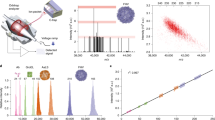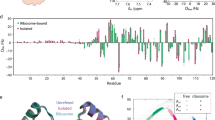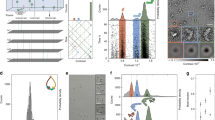Abstract
Investigation of the structure, assembly and function of protein–nucleic acid macromolecular machines requires multidimensional molecular and structural biology approaches. We describe modifications to an Orbitrap mass spectrometer, enabling high-resolution native MS analysis of 0.8- to 2.3-MDa prokaryotic 30S, 50S and 70S ribosome particles and the 9-MDa Flock House virus. The instrument's improved mass range and sensitivity readily exposes unexpected binding of the ribosome-associated protein SRA.
This is a preview of subscription content, access via your institution
Access options
Access Nature and 54 other Nature Portfolio journals
Get Nature+, our best-value online-access subscription
$29.99 / 30 days
cancel any time
Subscribe to this journal
Receive 12 print issues and online access
$259.00 per year
only $21.58 per issue
Buy this article
- Purchase on Springer Link
- Instant access to full article PDF
Prices may be subject to local taxes which are calculated during checkout



Similar content being viewed by others
Accession codes
References
Greber, B.J. et al. Science 348, 303–308 (2015).
Diebolder, C.A. et al. Science 343, 1260–1263 (2014).
Lössl, P., van de Waterbeemd, M. & Heck, A.J. EMBO J. http://dx.doi.org/10.15252/embj.201694818 (2016).
Heck, A.J. Nat. Methods 5, 927–933 (2008).
Martinez-Rucobo, F.W. et al. Mol. Cell 58, 1079–1089 (2015).
Rose, R.J., Damoc, E., Denisov, E., Makarov, A. & Heck, A.J. Nat. Methods 9, 1084–1086 (2012).
Rosati, S. et al. Angew. Chem. Int. Edn Engl. 51, 12992–12996 (2012).
van de Waterbeemd, M. et al. Angew. Chem. Int. Edn Engl. 53, 9660–9664 (2014).
Gault, J. et al. Nat. Methods 13, 333–336 (2016).
Yang, Y. et al. Nat. Commun. 7, 13397 (2016).
Snijder, J. et al. J. Am. Chem. Soc. 136, 7295–7299 (2014).
van de Waterbeemd, M. et al. J. Am. Soc. Mass Spectrom. 27, 1000–1009 (2016).
Belov, M.E. et al. Anal. Chem. 85, 11163–11173 (2013).
Wilson, D.N. & Nierhaus, K.H. Crit. Rev. Biochem. Mol. Biol. 40, 243–267 (2005).
Rostom, A.A. et al. Proc. Natl. Acad. Sci. USA 97, 5185–5190 (2000).
Lauber, M.A., Rappsilber, J. & Reilly, J.P. Mol. Cell. Proteomics 11, 1965–1976 (2012).
Izutsu, K. et al. J. Bacteriol. 183, 2765–2773 (2001).
Diaconu, M. et al. Cell 121, 991–1004 (2005).
Ilag, L.L. et al. Proc. Natl. Acad. Sci. USA 102, 8192–8197 (2005).
Bothner, B., Dong, X.F., Bibbs, L., Johnson, J.E. & Siuzdak, G. J. Biol. Chem. 273, 673–676 (1998).
Belov, M. US patent application US2015340213. (2015).
Snijder, J., Rose, R.J., Veesler, D., Johnson, J.E. & Heck, A.J.R. Angew. Chem. Int. Edn Engl. 52, 4020–4023 (2013).
Uetrecht, C. et al. Proc. Natl. Acad. Sci. USA 105, 9216–9220 (2008).
Sakata, E. et al. Mol. Cell 42, 637–649 (2011).
van den Heuvel, R.H.H. et al. Anal. Chem. 78, 7473–7483 (2006).
Giansanti, P., Tsiatsiani, L., Low, T.Y. & Heck, A.J.R. Nat. Protoc. 11, 993–1006 (2016).
Cox, J. & Mann, M. Nat. Biotechnol. 26, 1367–1372 (2008).
Schwanhäusser, B. et al. Nature 473, 337–342 (2011).
Acknowledgements
The authors would like to thank P. Lössl and F. Liu (Utrecht University) for assistance in the bottom-up LC-MS/MS analysis. M.v.d.W., K.L.F. and A.J.R.H. are funded by the large-scale proteomics facility Proteins@Work (Project 184.032.201) embedded in the Netherlands Proteomics Centre and supported by the Netherlands Organization for Scientific Research (NWO). M.v.d.W. and A.J.R.H. are also supported by a Projectruimte grant (12PR3303-2) from Fundamenteel Onderzoek der Materie (FOM). A.M. and A.J.R.H. acknowledge additional support through the European Union Horizon 2020 program FET-OPEN project MSmed, Project 686547. A.R. is supported by a University of Texas Medical Branch (UTMB) startup fund and the Texas Rising STARs Award from the University of Texas System.
Author information
Authors and Affiliations
Contributions
M.v.d.W., K.L.F., D.B. and M.R.-S. performed the experiments. M.v.d.W., K.L.F., A.M. and A.J.R.H. wrote the manuscript. A.R. provided FHV material. A.M. and A.J.R.H. supervised the modifications of the Orbitrap mass analyzer. A.M. and A.J.R.H. designed the study.
Corresponding author
Ethics declarations
Competing interests
D.B., M.R.-S. and A.M. are employees of Thermo Fisher Scientific, the manufacturer and supplier of Orbitrap-based mass spectrometers.
Integrated supplementary information
Supplementary Figure 1 Schematic of the QE-UHMR.
Several modifications were made to the Q-Exactive Plus mass spectrometer. Ions are trapped in the source region through a combination of elements: 1) the S-lens exit aperature with reduced diameter acts as the entrance lens to the ion trapping region, 2) the injection flatapole is pulsed down to a negative voltage termed desolvation voltage to assist with desolvation of large protein complexes and 3) the inter-flatapole lens is maintained at a high positive potential to prevent ions from eluting out of the injection flatapole region. Trapping is followed by restoration of the voltage levels allowing low-energy elution of trapped ions into the bent flatapole (4) where they get guided by an axial DC field and focused by an RF field. The RF frequencies of all ion routing multipoles were reduced: 4) 1.1 MHz on the bent flatapole, 5) 287 kHz on the quadrupole, 6) 900 kHz on the transport multipole, 7) 2.1 MHz in the C-trap and 8) 900 kHz in the HCD cell. Finally, 9) high mass ions were more efficiently injected into the Orbitrap mass analyzer by adjusting the slew rate of the high-voltage pulse that provides capture of ions in the analyzer.
Supplementary Figure 2 Native MS and top-down tandem MS capabilities of the QE-UHMR.
a) Mixtures of T=3 and T=4 hepatitis B virus capsids analyzed under charge reducing conditions span a wide mass range between 27,500 and 35,000 m/z. The spectrum, which contains well-resolved charge states for both particles, shows no bias for the 25% smaller T=3 particle. b) The high mass quadrupole can selectively isolate the 4 mega-Dalton T=4 particle for subsequent fragmentation. c) Top-down tandem MS spectrum of T=4 HBV capsids using 300 V HCD energy causes sequential ejection of up to 17 out of the 240 copies of the capsid protein. The ejected monomers appear at low mass to charge ratio while the concomitant product ions appear at increasingly higher mass to charge ratio. The inset shows an enlargement of the spectrum at 70,000 m/z containing well resolved HBV capsids that have lost between 14 and 17 capsid proteins (6.5% of the original mass) and 68% of the original charge. These data reveal ions can be detected by the Orbitrap mass analyzer up to at least 75,000 m/z.
Supplementary Figure 3 Low-mass region of a Q-ToF tandem MS experiment on 30S ribosome assemblies.
Isolation and fragmentation of 30S ribosomes reveals sra protein (A, 5095 Dalton) and RS6 protein (B, 15168, 15297, 15426 and 15553 Dalton).
Supplementary Figure 4 Low-mass region of a Q-ToF tandem MS experiment on Flock House virus.
Isolation and fragmentation of virions reveals peptide gamma (A, 4395 Dalton) and capsid protein beta (B, 39193 Dalton).
Supplementary information
Supplementary Text and Figures
Supplementary Figures 1–4 and Supplementary Tables 1–4 (PDF 542 kb)
Supplementary Data
List of proteins identified in ribosome preparations through bottom-up LC-MS/MS analysis and their intensity-based absolute quantification value. (XLSX 21 kb)
Rights and permissions
About this article
Cite this article
van de Waterbeemd, M., Fort, K., Boll, D. et al. High-fidelity mass analysis unveils heterogeneity in intact ribosomal particles. Nat Methods 14, 283–286 (2017). https://doi.org/10.1038/nmeth.4147
Received:
Accepted:
Published:
Issue Date:
DOI: https://doi.org/10.1038/nmeth.4147
This article is cited by
-
The Ruminococcus bromii amylosome protein Sas6 binds single and double helical α-glucan structures in starch
Nature Structural & Molecular Biology (2024)
-
Mass spectrometry using electrospray ionization
Nature Reviews Methods Primers (2023)
-
Advances in mass spectrometry to unravel the structure and function of protein condensates
Nature Protocols (2023)
-
Frequency chasing of individual megadalton ions in an Orbitrap analyser improves precision of analysis in single-molecule mass spectrometry
Nature Chemistry (2022)
-
Complete and cooperative in vitro assembly of computationally designed self-assembling protein nanomaterials
Nature Communications (2021)



